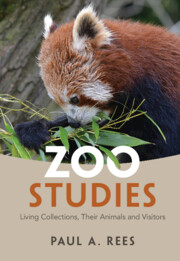Book contents
- Zoo Studies
- Zoo Studies
- Copyright page
- Dedication
- Contents
- Preface
- Acknowledgements
- Abbreviations
- 1 Zoos and Research
- 2 Defining Zoos, Their Culture and Visitors
- 3 Zoos and Education
- 4 Anthrozoology and Visitor Behaviour
- 5 Zoo Organisation and Regulation
- 6 Ethics, Zoos and Public Attitudes
- 7 The Contribution of Zoos to Zoology
- 8 Animals and Their Enclosures
- 9 Animal Welfare
- 10 Enrichment and Training
- 11 Conservation Breeding, Reproduction and Genetics
- 12 Restoration, Rehabilitation and In-Situ Conservation
- 13 Animal Nutrition and Conservation Medicine
- 14 The Past and Future of Zoos
- Bibliography
- References
- Subject Index
- Animal Species Index
8 - Animals and Their Enclosures
Published online by Cambridge University Press: 12 May 2023
- Zoo Studies
- Zoo Studies
- Copyright page
- Dedication
- Contents
- Preface
- Acknowledgements
- Abbreviations
- 1 Zoos and Research
- 2 Defining Zoos, Their Culture and Visitors
- 3 Zoos and Education
- 4 Anthrozoology and Visitor Behaviour
- 5 Zoo Organisation and Regulation
- 6 Ethics, Zoos and Public Attitudes
- 7 The Contribution of Zoos to Zoology
- 8 Animals and Their Enclosures
- 9 Animal Welfare
- 10 Enrichment and Training
- 11 Conservation Breeding, Reproduction and Genetics
- 12 Restoration, Rehabilitation and In-Situ Conservation
- 13 Animal Nutrition and Conservation Medicine
- 14 The Past and Future of Zoos
- Bibliography
- References
- Subject Index
- Animal Species Index
Summary
This chapter discusses the design of zoo enclosures and briefly considers important stages in the history of zoo design. Animals must be safely contained within zoos and the nature of the containment varies between species. From time to time containment methods fail and animals escape, sometimes with fatal consequence for them and the people they encounter. There is an ongoing debate about the appropriate amount of space required for some species, especially large carnivores and other wide-ranging taxa. Minimum space requirements for taxa are arbitrarily determined, and usable space and enclosure shape should be considered when enclosures are designed. A number of studies have examined enclosure use by zoo animals, the need for shade and an appropriate substratum. Visitor behaviour may affect enclosure use in some taxa. Enclosure design is a compromise between the need that animals have to avoid the gaze of the public and the desire of visitors to see the animals.
- Type
- Chapter
- Information
- Zoo StudiesLiving Collections, Their Animals and Visitors, pp. 163 - 197Publisher: Cambridge University PressPrint publication year: 2023

